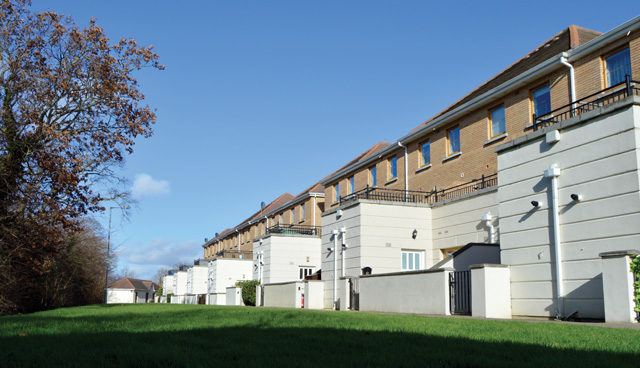
District heating: The future for decarbonising Irish housing stock
17th May 2019
Rebuilding Ireland: Where are we now?
17th May 2019Cover story: A new model for social housing


Circle Voluntary Housing Association CEO John Hannigan speaks with Odrán Waldron about how reclassification is impeding the ability of Associated Housing Bodies (AHBs) to meet their goals under Rebuilding Ireland and the realities of the provision of social housing in Ireland.
“We’re still in crisis in terms of the development and delivery of public housing,” Hannigan begins from Circle’s head office in the Christchurch area of Dublin. “The requirement is for close to 15,000 properties year-on-year. At the moment, we’re at about 2,500 to 3,000 in total from the AHB sector alone. In terms of combined provision, we were at nearly 5,000, so we’re about 10,000 short still.”
Circle are attempting to address the shortage from their end; Hannigan details plans to triple their output and grow to over 3,500 properties managed but says that the association have found it difficult to attract private investors in an increasingly turbulent housing market.
“What we’re finding is that developers have been slow coming to us with what they provide,” he says. “We have restrictions placed on what we can borrow and how we can borrow by and from the State; we have a dependency on local authorities for sites, which is restricting how we do things, and then we have a shortage of skills which makes it more expensive to build housing because of scarcity.
“The whole of the public system is slow to deliver. In 2009, we were delivering 90,000 properties a year, we’re delivering close to 25,000 a year now. We’re way off where we should be as a state, which is why we have rising numbers in homelessness and in waiting lists for social housing.”
One of the aspects standing in the way of the delivery of social housing is a reluctance to build social housing into private developments as facilitated by Part V of the Planning and Development Act 2000. The mechanism allows the relevant local authority to obtain a minimum of 10 per cent of land zoned for development at its existing value rather than its developmental value. Exemptions can be obtained by developers, which has been the subject of controversy in Dublin’s Docklands.
“The reality is that it impacts on what developers develop and affects the process of what they can sell within their estates,” Hannigan says. “Take for example the issue on the Docklands where there have been three developments undertaken with no social housing: the reason for that is that the state couldn’t afford to pay the prices on properties like that. They could build in Clondalkin or Tallaght for a fraction of the price. Developers provide some social housing but not as much as you would want.”

“We have the capacity as an alliance to provide more than we have provided, but we are certain that if the Government don’t do something practical to get us off the balance sheet then that level of delivery is going to be diminished and then the targets within Rebuilding Ireland become very hard to achieve.”
Hannigan and Circle’s plans involve returning to a time when AHBs could be more decisive and play a bigger role in both the provision and building of social housing: “As an organisation Circle are a bit more proactive, we want to take back control of our delivery.
“In the early 2000s, AHBs could go out, buy land and deliver social housing. They would work as the main developer and bring in other developers and builders. Since 2010 that’s changed because of the downturn and developers took control and would then give some social housing. We’re trying to go back to that process where we were in control; it requires a bit more risk than we’re used to but that’s something that we’re all going to have to get used to. It’s not a huge risk, but it’s different from what we’ve done previously.”

Circle VHA’s Stocking Well in Rathfarnham, Dublin.
“The old adage about social housing being for unemployed people and known for antisocial behaviour is rubbish; social housing today incorporates people who are employed, people who have had jobs and lost them because of the downturn.”
Leading the calls for these changes is the Housing Alliance, made up of six or Ireland’s larger AHBs – Circle, Clúid Housing, Co-operative Housing Ireland, Oaklee Housing, Respond, and Túath Housing. One of the key issues raised by the Housing Alliance that they say would aid the delivery of social housing is that of reclassification, the mechanism by which all money received by AHBs has been classified as government spending, despite Hannigan’s estimate that only 25 per cent of the capital money received by AHBs is centrally funded.
“People think everything we do is state funded but it’s not: up to recently, it was historically 100 per cent government funded, but since about 2010 it’s been roughly 25 per cent government funded which means the rest comes from private funding,” Hannigan explains. That means we take more risks and have to be more professional in our management. What it also meant is that the State could have more property for less investment and this new classification change means Europe has decided that all our borrowing is state borrowing.
“Practically this means that every euro we get from the State is counted, but also everything we get from elsewhere is also counted against the State’s balance sheet. We have to compete with things like the National Children’s Hospital, the Luas or the MetroLink or the broadband programme on a house-by-house basis now to make sure things get done.”
It is the issue that is defining the current struggle for AHBs to meet the targets set out for them by the Government in the Rebuilding Ireland plan. Hannigan says that he understands it is “very technical”, but one that the Housing Alliance “need people to understand”. “While there haven’t been controls put in place yet, there’s talk of controls and when there’s talk of controls investors begin to look at it and slowing down the pipeline of funding,” he says. “We’re beginning to see a small slowdown in the delivery of housing. It hasn’t bitten fully yet but it’s likely to over the next year and if this continues then we’re likely to see a real slowdown that would effectively destroy the whole thing and lead to more families on the social housing waiting lists.
“The element of Rebuilding Ireland that relates to AHBs is out the window in this scenario. We were tasked with delivering a third of the 50,000 properties to be delivered, but if reclassification continues then the supply of housing will have significantly diminished from our sector. We have the capacity as an alliance to provide more than we have provided, but we are certain that if the Government don’t do something practical to get us off the balance sheet then that level of delivery is going to be diminished and then the targets within Rebuilding Ireland become very hard to achieve.”
The reclassification issue is a major obstacle in terms of delivery, but Hannigan explains that existence of the Alliance’s united front allows for the other aspects of delivery run more smoothly. Hannigan says that Ireland needs “a new model for social housing” and that the Alliance can help to deliver one: “We’re looking at options on how we can work together on bigger sites. The six of us together can work on a bigger scale, you’re talking about going from managing 100 new homes to 1,000 new homes. Bringing all these groups together also brings more credibility when working with developers when they see a group who have been working together for a period of time. It’s offering a different opportunity to the market.”
The austere economic realities that followed the downturn meant that housing funding was severely slashed, and the market was increasingly left to private developers, themselves reluctant to build in the large numbers required for the increasing demand in Ireland. Hannigan acknowledges this, but sees potential for the delivery from AHBs to expand significantly: “Now the State has realised that this the number one political issue and invested in it. Our delivery team has gone from one person to six, operating across most of the country.
“If you take the Alliance in total, we had a programme for nearly 6,000 properties this year alone in 2018. We’re (Circle) going from 350 properties built and delivered this year to nearly 800 next year, so these are very big programmes for all involved. Overall, we think we can hit close to 8-9,000 properties a year, as an alliance if given the funding opportunities.”

Hannigan has over 25 years of experience working within social housing, either in the United Kingdom or Ireland since 1992. It is such vast experience that brings him full circle to the issue of minimum percentages of social housing within private developments. “There’s always been an argument that we need dispersed social housing because it’s better for social integration, but actually if you have really good central management, which the big AHBs have, you can house as many people as you want in social housing because what you’re doing is building a community,” he says.
“The old adage about social housing being for unemployed people and known for antisocial behaviour is rubbish; social housing today incorporates people who are employed, people who have had jobs and lost them because of the downturn. These are highly skilled and highly knowledgeable people who want to work and who do work but who can’t get a house because of the pricing.
We need to provide a product for individuals who can afford to pay something but not the current prices: be that to purchase or to rent. In Dublin a one bed apartment is costing you €1,500 to €1,600 minimum; if you go down to Cork or Galway it’s €800, which still isn’t affordable.”
Hannigan concludes by expressing the opinion that Part V’s minimum requirement for social housing isn’t enough and that it should be 20 per cent. “At the moment the Land Development Agency is talking about 60 per cent private, 30 per cent affordable and 10 per cent social for all state land for the future. I think those proportions are wrong, it should be 20 per cent social, 30-40 per cent affordable. The private developer would still make his money on the build and the sale of the social and affordable houses,” he says.
“If we’re going to achieve the society that is desired over the next five years, then change is required.”
Profile: John Hannigan
John Hannigan has been Chief Executive Officer of Circle Voluntary Housing Association, one of Ireland’s largest Tier 3 Approved Housing Bodies, since September 2017. Prior to this John was Managing Director of Sunbeam House Services from 2010 to 2017 and Company Treasurer of Respond Housing Association from 2004 to 2010 in Ireland and South Africa.
John has worked at senior executive level within the private sector (KPMG, Grant Thornton and EY) and as Group Director and Company Secretary in the UK for large Registered Social Landlords (Accord and Prime Focus). John is a Chartered Member of the Chartered Institute of Housing, a Fellow of the Association of Certified Accountants and a member of the Institute of Directors in Ireland. John is also a member of the Governing Board of the Chartered Institute of Housing. He graduated from Warwick Business School with and MBA in 2001.




